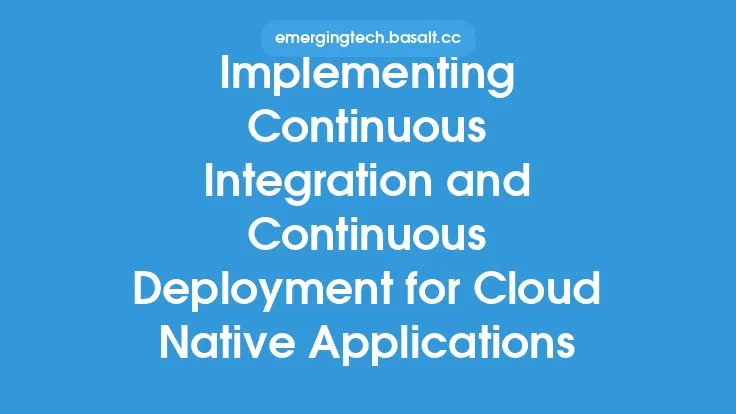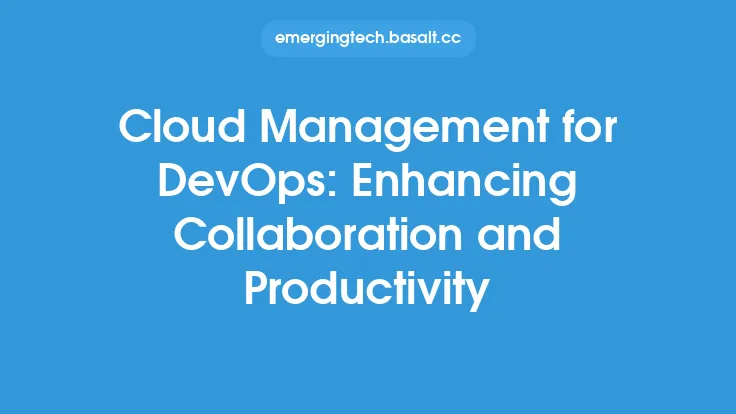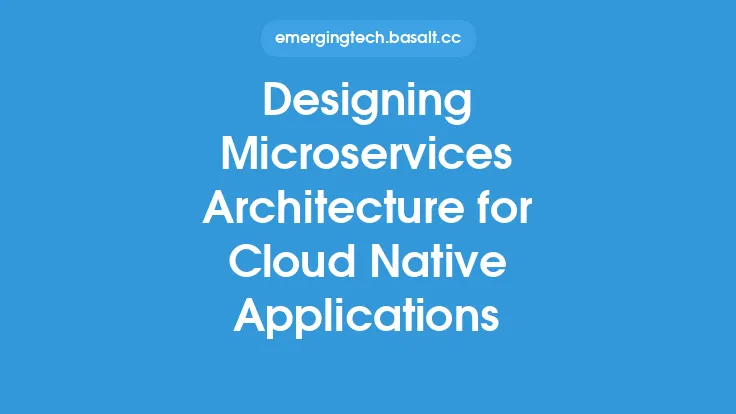The concept of cloud native applications has revolutionized the way we develop, deploy, and manage software systems. By leveraging the scalability, flexibility, and on-demand resources of the cloud, organizations can create applications that are more agile, resilient, and responsive to changing business needs. At the heart of this revolution is the convergence of cloud native applications and DevOps, a cultural and technical movement that emphasizes collaboration, automation, and continuous improvement. In this article, we will explore the perfect match between cloud native applications and DevOps, and how this synergy can help organizations achieve greater efficiency, innovation, and competitiveness.
Introduction to Cloud Native Applications
Cloud native applications are designed to take full advantage of the cloud computing model, which is characterized by on-demand self-service, broad network access, resource pooling, rapid elasticity, and measured service. These applications are built using a microservices architecture, which allows for greater modularity, scalability, and fault tolerance. Cloud native applications are also highly automated, with a focus on continuous integration, continuous deployment, and continuous monitoring. This enables organizations to respond quickly to changing business needs, improve customer experience, and reduce the risk of errors and downtime.
DevOps and its Core Principles
DevOps is a set of practices that combines software development (Dev) and IT operations (Ops) to improve the speed, quality, and reliability of software releases. The core principles of DevOps include culture, automation, measurement, and sharing. Culture refers to the collaboration and communication between development and operations teams, as well as the adoption of a DevOps mindset that emphasizes continuous improvement and learning. Automation involves the use of tools and scripts to streamline and accelerate software development, testing, and deployment. Measurement involves the use of metrics and feedback to monitor and optimize software performance, while sharing involves the exchange of knowledge, expertise, and best practices across teams and organizations.
The Convergence of Cloud Native Applications and DevOps
The convergence of cloud native applications and DevOps is a natural fit, as both share a common goal of improving the speed, quality, and reliability of software releases. Cloud native applications provide the perfect platform for DevOps practices, as they are designed to be highly automated, scalable, and resilient. DevOps, in turn, provides the cultural and technical foundation for cloud native applications, enabling organizations to adopt a continuous delivery model that emphasizes rapid iteration, feedback, and improvement. By combining cloud native applications and DevOps, organizations can create a powerful feedback loop that enables them to respond quickly to changing business needs, improve customer experience, and reduce the risk of errors and downtime.
Key Benefits of Cloud Native Applications and DevOps
The combination of cloud native applications and DevOps offers several key benefits, including improved speed and agility, increased quality and reliability, and enhanced customer experience. Cloud native applications enable organizations to develop and deploy software faster, using automated pipelines and continuous integration. DevOps practices, such as continuous monitoring and feedback, help to ensure that software is reliable, stable, and performant. The combination of cloud native applications and DevOps also enables organizations to respond quickly to changing business needs, using agile development methodologies and rapid iteration. Finally, the use of cloud native applications and DevOps helps to improve customer experience, by providing a more responsive, resilient, and personalized experience.
Technical Requirements for Cloud Native Applications and DevOps
To implement cloud native applications and DevOps, organizations need to have a range of technical skills and tools. These include expertise in programming languages such as Java, Python, and Node.js, as well as experience with cloud platforms such as Amazon Web Services, Microsoft Azure, and Google Cloud Platform. Organizations also need to have experience with DevOps tools such as Jenkins, Docker, and Kubernetes, as well as monitoring and logging tools such as Prometheus, Grafana, and ELK. Additionally, organizations need to have a good understanding of agile development methodologies, such as Scrum and Kanban, as well as experience with continuous integration and continuous deployment pipelines.
Best Practices for Implementing Cloud Native Applications and DevOps
To get the most out of cloud native applications and DevOps, organizations need to follow a range of best practices. These include adopting a DevOps mindset and culture, using automated pipelines and continuous integration, and monitoring and feedback to optimize software performance. Organizations should also use cloud native services and platforms, such as serverless computing and containers, to improve scalability and reduce costs. Additionally, organizations should prioritize security and compliance, using tools and practices such as encryption, access control, and auditing to protect sensitive data and applications. Finally, organizations should continuously learn and improve, using feedback and metrics to refine their DevOps practices and improve software quality.
Real-World Examples of Cloud Native Applications and DevOps
There are many real-world examples of cloud native applications and DevOps in action. For example, companies such as Netflix, Amazon, and Google use cloud native applications and DevOps to deliver highly scalable and resilient software services. Other companies, such as Walmart and Target, use cloud native applications and DevOps to improve customer experience and reduce costs. In the financial sector, companies such as Goldman Sachs and Citigroup use cloud native applications and DevOps to improve trading platforms and reduce risk. These examples demonstrate the power and potential of cloud native applications and DevOps, and show how organizations can use these technologies to achieve greater efficiency, innovation, and competitiveness.
Conclusion
In conclusion, the combination of cloud native applications and DevOps is a perfect match, enabling organizations to create highly scalable, resilient, and responsive software systems. By leveraging the scalability, flexibility, and on-demand resources of the cloud, organizations can create applications that are more agile, innovative, and customer-centric. DevOps provides the cultural and technical foundation for cloud native applications, enabling organizations to adopt a continuous delivery model that emphasizes rapid iteration, feedback, and improvement. As organizations continue to adopt cloud native applications and DevOps, we can expect to see even more innovative and disruptive technologies emerge, transforming the way we develop, deploy, and manage software systems.





